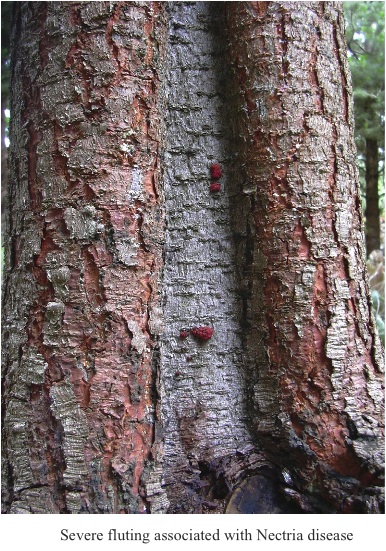PESTS AND DISEASES OF FORESTRY IN NEW ZEALAND
Nectria disease of radiata pine
Scion is the leading provider of forest-related knowledge in New Zealand
Formerly known as the Forest Research Institute, Scion has been a leader in research relating to forest health for over 50 years. The Rotorua-based Crown Research Institute continues to provide science that will protect all forests from damage caused by insect pests, pathogens and weeds. The information presented below arises from these research activities.
From Forest Health News 165, August 2006.
A relationship between pruning and the presence of N. fuckeliana?
 Nectria fuckeliana is widely distributed throughout the Otago/Southland region and it is hypothesised that the fungus is the causal agent of the flute canker disease of Pinus radiata (see FH News 155, September 2005). The infection spreads upwards and downwards from the entry point, killing cambium cells and resulting in the flute canker symptom.
Nectria fuckeliana is widely distributed throughout the Otago/Southland region and it is hypothesised that the fungus is the causal agent of the flute canker disease of Pinus radiata (see FH News 155, September 2005). The infection spreads upwards and downwards from the entry point, killing cambium cells and resulting in the flute canker symptom.
It is believed that the disease is initiated by the entrance of N. fuckeliana spores through pruning wounds. The objective of the research conducted in this project was to use a DNA-based identification system to detect the presence of N. fuckeliana within pruned and unpruned trees to determine if there is a relationship between pruning and the presence of N. fuckeliana.
Wood cores were collected from three forests in Otago (Tokoiti, Otago Coast, and Berwick Forests) using an increment borer. Half of the cores collected from each site were from young trees which had recently received their first pruning, and the other half were from trees in the same stand which had not been pruned. One hundred and eighty trees were sampled and one core was removed from each tree. Small rounds were cut from the core and ground to a fine powder in liquid nitrogen. DNA was extracted from the powdered tissue, and PCR (polymerase chain reaction) procedures were performed using the N. fuckeliana -specific method previously developed by Ensis.
The majority of the trees sampled showed none of the symptoms associated with N. fuckeliana infection (i.e., fluting or fruiting bodies); therefore, a low number of positive results were expected.
Also, based on the currently hypothesised mechanism of host infection, the great majority of unpruned trees were not expected to be positive for the presence of N. fuckeliana. PCR procedures detected Nectria fuckeliana in both pruned and
unpruned trees from all three forests. Of the 180 cores tested, 41 produced positive results for N. fuckeliana , 19 of them from pruned trees and 22 from unpruned trees. These results suggest that the presence of the fungus was not dependent on entry through pruning wounds as there was no significant difference between pruned and unpruned trees in the presence of the fungus. This result was unexpected.
It should be emphasised that these results are preliminary and future investigation is planned. The field sites will be revisited in 2007, all trees will be visually inspected, and any symptoms of the fungus will be recorded. Additional samples from the trees which had inconsistent results, and trees that appear to have early symptoms of infection by N. fuckeliana , will be collected and analysed in 2007.
Matt Power & Tod Ramsfield, Ensis
This information is intended for general interest only. It is not intended to be a substitute for specific specialist advice on any matter and should not be relied on for that purpose. Scion will not be liable for any direct, indirect, incidental, special, consequential or exemplary damages, loss of profits, or any other intangible losses that result from using the information provided on this site.
(Scion is the trading name of the New Zealand Forest Research Institute Limited.)

 Farm Forestry New Zealand
Farm Forestry New Zealand

